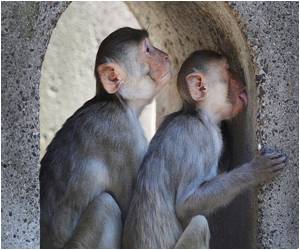Primates modify their body movements to be in tune with others, just like humans do.

In the research, published today in the journal Scientific Reports, the team led by Naotaka Fujii developed an experimental set-up to test whether pairs of Japanese macaque monkeys synchronize a simple push-button movement.
Before the experiment, the monkeys were trained to push a button with one hand. In a first experiment the monkeys were paired and placed facing each other and the timing of their push-button movements was recorded. The same experiment was repeated but this time each monkey was shown videos of another monkey pushing a button at varying speeds. And in a last experiment the macaques were not allowed to either see or hear their video-partner.
The results show that the monkeys modified their movements – increased or decreased the speed of their push-button movement - to be in synchrony with their partner, both when the partner was real and on video. The speed of the button pressing movement changed to be in harmonic or sub-harmonic synchrony with the partners' speed. However, different pairs of monkeys synchronized differently and reached different speeds, and the monkeys synchronized their movements the most when they could both see and hear their partner.
The researchers note that this behavior cannot have been learnt by the monkeys during the experiment, as previous research has shown that it is extremely difficult for monkeys to learn intentional synchronization.
They add: "The reasons why the monkeys showed behavioral synchronization are not clear. It may be a vital aspect of other socially adaptive behavior, important for survival in the wild."
Advertisement









